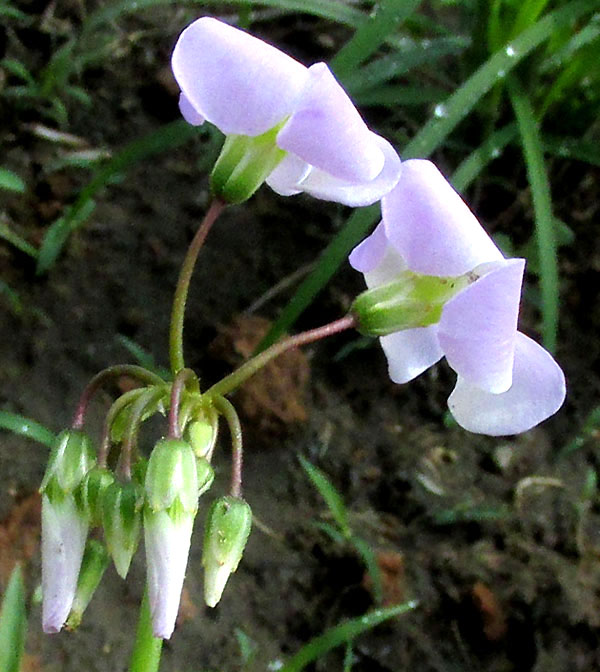Excerpts from Jim Conrad's
Naturalist Newsletter
entry dated August 30, 2022, issued from near Tequisquiapan, elevation about 1,900m (6200 ft), N20.565°, W99.890°, Querétaro state, MÉXICO
TENLEAF WOODSORREL

On a mound of pushed-up dirt and gravel along a small gravel road surrounded by abandoned agricultural fields, the above herb formed a solid mass of leaves and flowers about the size of an average Mexican street-dog. Rain had fallen during the night and at 10:30AM the leaves still were beaded with water, yet the flower's petals curled downward as if a little wilted.
It's the leaves that catch one's attention, though, divided as they are into several leaflets, the leaflets uniting at their bases to form something like a shredded umbrella, with each narrow shred forked at its tip.

If there's any indecision about whether this plant is an oxalis, or woodsorrel, a closer look at the flowers dispels any doubt. Not only the pale violet color, typical among the oxalises, but also the manner by which the immature flowers droop so demurely from the top of the blossoms' peduncle is pure oxalis.

The view into a flower's throat also shows typical oxalis features. Amid the five petals are ten stamens, the stamens alternating with one another on long and short filaments. In the above picture, the oval, grainy anthers of five tall stamens rise conspicuously above five lower ones, of which in the shadows only two low anthers are easily seen. The female pistil consisting of stigma, style and ovary is hidden lower down.
Depending on the species, oxalis flowers can exhibit one of four different strategies with regard to stamen height relative to the stamens themselves, and style height. The four manners are tristyly, distyly, semihomostyly and homostyly. Our species displaying stamens of two heights and all stamens well above the style, is distylous. Wikipedia provides a page on distyly in flowers. It all has to do with keeping flowers from pollinating themselves.

So, despite our plant's leaves being very unlike the trifoliate "shamrock" or cloverleaf form northern gardeners and wildflower appreciaters associate with oxalis plants, we do have an oxalis. However, the genus Oxalis comprises about 700 species, many of which are weedy and likely to appear along gravel roads. For our semiarid, upland, central Mexican region known as the Bajío, about 14 species have been documented. Which of those do we have?
In the picture, important clues to our plant's species identity include that the corolla is 3-5 times longer than the sepals, not 2-3 as with a closely related species. Also it's worth noticing that each sepal tip bears a "tubercle," looking like a dark wart. Some Oxalis species don't have such things, or have them in different places. The warts are oxalate deposits -- oxalises are full of oxalic acid -- and, depending on the species, such deposits may occur as orange or blackish dots or stripes, not only on sepal tips but on leaf blades and sepal margins.
One reason oxalis species produce such large concentrations of oxalates is that the compounds enable the plants to avoid aluminum toxicity when growing in acid soils. Another is that it's a defense against insects and animals who avoid eating acid food. Various oxalis species able to live in mining areas with soils contaminated with copper, mercury, arsenic and other toxic minerals are being used to rehabilitate spoiled soils, in a process known as phytoremediation -- using plant to clean up hazardous contaminants. Wikipedia has a Phytoremediation page.
With our weedy oxalis revealing so many interesting features, it's easy enough to determine that our plant is OXALIS DECAPHYLLA, often referred to in English as Tenleaf Woodsorrel, though its leaflets range in number from three to eleven.
Tenleaf Woodsorrel is distributed from dry, mountainous parts of Arizona and New Mexico in the US southwest to about here and the central Mexican states of Hidalgo and Jalisco. The species inhabits various kinds of disturbed areas, including those in forests of oak and pine, at elevations of 1050-2550m (3400-8400ft). This is yet another species introduced to science when Humboldt and Bonpland visited Mexico in 1803 and 1804. They collected the species in Puebla and Veracruz states.
All the oxalate-rich oxalis species are used variously as food (an acid tang in salads) and in traditional medicine (mainly for kidney problems). With regard to human use of oxalis species, there's always a discussion about the fact that most kidney stones are formed when oxalate binds to calcium while urine is produced by the kidneys. The consensus appears to be that eating modest amounts of oxalis is fine, unless kidney problems already exist, but eating oxalis habitually is to be avoided.